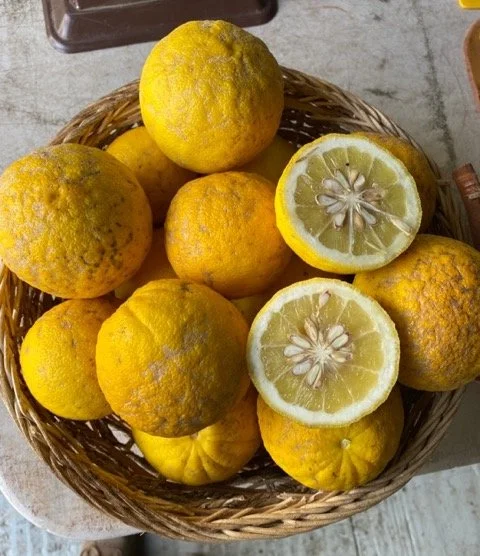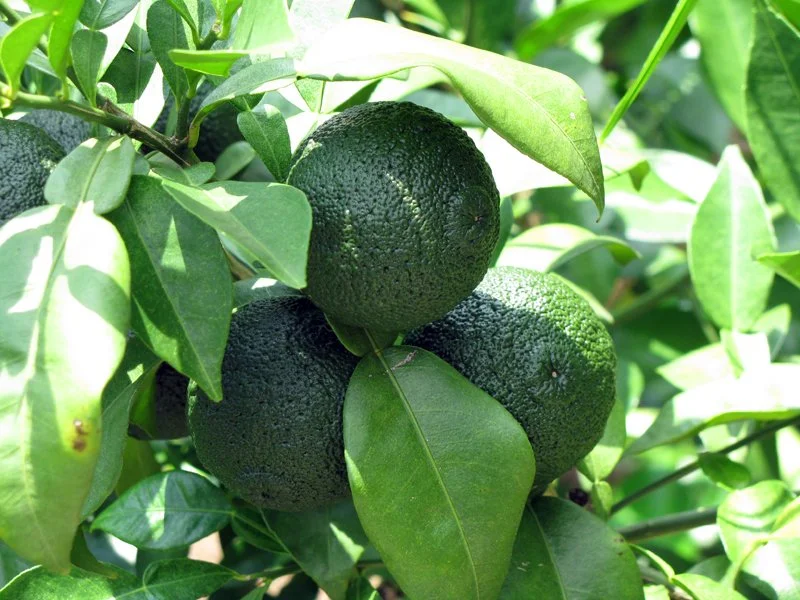Citrus
Citrus is originally from a broad area including southeast Asia and Oceania, with its center of origin located in the southeast foothills of the Himalayas. Citrus are subtropical and tropical plants, and are best adapted to those climates. They like plenty of sun and water in summer; they also grow very well in mediterranean climates, but with the help of supplemental water. Besides eating out of hand, fruit in the citrus family is used for its juice, as well as its peel candied or as a spice.
As for us here in the Northwest, we are straddling the border between a cooler mediterranean climate and an oceanic one, and situated farther north than any other mediterranean area in the world. The Pacific Northwest is just barely able to grow citrus. The main limitations are the freezing temperatures we experience and the shorter, cooler growing season. Often, citrus enthusiasts in the Northwest will grow citrus in pots, and move them into shelter for the winter. This article, however, is only about the citrus varieties that can successfully grow outside, year-round.
Citrus in our region ripens in fall and winter, but can be picked earlier if the fruit is usable green.
In the Pacific Northwest
Northwest Coast
There are a handful of citrus and related species that are cold-hardy, generally originating in China. Unfortunately, they are generally unpalatable, but thanks to the fact that citrus hybridizes freely, people have been able to breed a number of promising plants. Many of these hybrids were developed in Japan, which for our purposes is an area of particular interest.
For the Northwest Coast, the species that are most viable are the ichang papeda, the trifoliate orange, and their hybrids. Northern California is a little warmer, and so is able to grow mandarins, kumquats, and their hybrids as well. Unfortunately, it’s generally just too cold in the Inland Northwest for citrus. See this article for more information about culinary regions.
There is currently no real culture of growing citrus commercially along the Northwest Coast, but local horticulturists and nurseries have put a lot of work into figuring out what works here, and there are very clear winners for our region. The world of cold-hardy citrus is still actively being explored, so I expect that more varieties will pop up as that work continues.
Northern California
In addition to the varieties listed above for the Northwest Coast, Northern California (the Klamath Mountains and Sacramento Valley regions) can also grow a number of mandarin and kumquat varieties. With the right micro-climate, the hardier of these may be viable in the Northwest Coast region.
In the Klamath Mountains region, there’s a small area near Brookings, Oregon, known for its ability to grow Meyer lemons and mandarins. The record low for the area is 20°F. There are other parts of the Oregon coast where the record low was only around 12-14°F as well. The main concern growing in these areas is the lack of heat in summer which may affect the ability to ripen fruit.
In the Sacramento Valley, there are commercial growers of mandarins, and even a very small number of navel oranges. There were once many orange growers, but the occasional hard freeze (about every 20 years) has reduced the acreage to nearly nothing, and has been replaced with mandarins. I don’t consider oranges to be viable. The record low temperature for Chico, CA is 11°F, and the record low for Oroville, CA is 12°F. These freezes are generally short-lived. Although these record lows are too low for some of the fruit on this list, there are many microclimates in the area.
With climate change, the hardiest of these are likely to become viable further north.
Cold hardiness
One of the trade-offs of cold hardiness is often palatability. Cold-hardy citrus is generally unsuitable for eating out of hand, and is best used for cooking or with other ingredients. Most are acid fruits, rather than sweet, with the notable exception of mandarins.
For citrus, cold hardiness numbers apply to mature citrus trees which have had time to harden off and go into dormancy before being hit with low temperatures. The plants generally can’t handle more than a few hours at the very lowest temperatures they are hardy to.
For many of the citrus in this article, the choice of rootstock also has an impact; for example, plants grafted onto trifoliate orange roots will be able to handle lower temperatures.
I consider a citrus type viable for a region if they can handle most of the low temperatures that can be expected there, with the possibility of requiring some minor protection during rare major freezes.
Species and varieties
Ichang papeda and hybrids
Ichang papeda (Citrus cavaleriei)
Ichang lemon (unknown × junos)
Yuzu (Citrus × junos)
Sudachi (unknown × junos)
Kabosu (Citrus reticulata × junos)
Trifoliate orange and hybrids
Trifoliate orange (Poncirus trifoliata)
‘Flying Dragon’
Citrumelo (Citrus paradisi × Poncirus trifoliata)
Citrange (Citrus × insitorum)
Mandarins and hybrids
Mandarin (Citrus reticulata)
‘Changsha’
‘Satsuma’
Meyer lemon (Citrus × meyeri)
Calamansi (Citrus × microcarpa)
Sour orange (Citrus × aurantium)
‘Chinotto’
‘Nansho daidai’
Kumquats
Kumquat (Citrus japonica)
‘Nagami’
‘Fukushu’
‘Meiwa’
‘Marumi’
Ichang papeda and hybrids
The ichang papeda (Citrus cavaleriei) a wild citrus from China known for its hardiness and resistance to wetness.
As a result, several hybrids have been developed from it.
The ichang papeda is not usually considered palatable but there are many hybrids derived from it with good culinary value. There is a full-grown ichang papeda tree growing in the Hoyt Arboretum. The leaves and peel are known to be highly aromatic.
Hybrids
The ichang lemon (unknown × junos) is an ichang papeda cross of which the parentage is uncertain. Apparently cultivated in China. There’s not a lot of information about this one, but it’s definitely one to explore. Also known as a ‘Shangyuan’.
The yuzu is believed to have originated in central China as a hybrid of a wild mandarin and the ichang papeda. It’s grown mostly in Japan, and has recently enjoyed a surge in popularity around the world.
The peel is highly aromatic and useful. The juice is acidic and slightly resinous, but flavorful, and makes a great cooking ingredient or lemonade. Along with the sudachi and kabosu, yuzu juice is used in Japanese cooking to make ponzu sauce.
Yuzu (Citrus × junos) are hardy to 0°F and have been confirmed to grow well in the Pacific Northwest. They can be grown in the ground all the way up the coast of British Columbia.
Lesser known but similar to yuzu, the sudachi is also very hardy (down to at least 10°F). Sudachi (unknown × junos) are also proven to grow in the ground in British Columbia. The flavor is a bit heavier than yuzu, almost like a lime versus a lemon. Usually picked green in Japan.
Another ichang papeda hybrid from Japan, the kabosu (Citrus reticulata × junos) is similar to both the yuzu and sudachi. There’s less information about the kabosu than either of those, but it’s in same range of flavor and hardiness. Also usually picked green.
Trifoliate orange and hybrids
The trifoliate orange (Poncirus trifoliata), or hardy orange, is the hardiest citrus out there (down to -5°F).
Not a true citrus, it’s actually from a related genus. Interestingly, the plant is deciduous in winter. It’s commonly used as a rootstock to dwarf plants and provide greater cold resistance. It also hybridizes easily with other citrus, though many of the crosses are not considered palatable. You can find quite a few of these trees, usually the dwarf ‘Flying Dragon’ variety, around Portland.
The flavor is very tart, with a distinct resinous quality that some find unpleasant. The fruit is low in juice, but I personally think it’s interesting as a cooking ingredient and has culinary merit. The peel is highly flavorful and should be used as a spice. A little bit goes a long way. The fruit can be stored for a couple of months to increase the juice yield.
Hybrids
A citrumelo is a cross between a grapefruit and trifoliate orange. Apparently, a full-grown ‘Dunstan’ citrumelo (C. paradisi × P. trifoliata) tree can be found at a home in NE Portland; I haven’t verified this. The fruit is supposed to be of a decent size and palatability, with a flavor similar to old-fashioned white grapefruit but more sour.
The citrange (Citrus × insitorum) is a cross between an orange and a trifoliate orange. The ‘Troyer’ and ‘Carrizo’ varieties are said to have the best flavor.
Mandarins and hybrids
Some varieties of mandarin, such as ‘Changsha’, are supposed to be hardy down to even 12°F.
Quite a few mandarin (Citrus reticulata) varieties are great picks for Northern California. ‘Satsuma’ mandarins are commercially produced in the Sierra Nevada foothills and Northern California, where the cooler weather produces excellent fruit. Of all the cold-hardy citrus, mandarins are the best for eating out of hand. They’re easy to peel and have a sweet flavor similar to oranges.
Hybrids
The Meyer lemon is a cross between a citron and a mandarin/pomelo hybrid. It is hardy to about 20°F. Sweeter and less acidic than a lemon, and highly aromatic. The Meyer lemon (Citrus × meyeri) is a very popular citrus in the western US.
Popular in the Philippines, calamansi (Citrus × microcarpa) are a natural hybrid between a kumquat and a sour mandarin. Also known as a calamondin. I’ve seen claims of calamansi being hardy to 16°F, but personally, I find this doubtful. 20°F seems to be more of the consensus. The fruit is sour and often used as a replacement for limes.
The chinotto orange, also known as the myrtle-leaved orange (Citrus × aurantium ‘Chinotto’), is considered hardy to 20°F. A type of sour orange, this is a cross between a mandarin and a pomelo, same as the sweet orange, but with different results. Sour oranges are bitter and sour, and not palatable when eaten out of hand, but they are commonly used as a flavoring in liqueurs or Italian sodas. You’re most likely to have tasted it as one of the ingredients in Campari.
The nansho daidai orange is another variety of sour orange (Citrus × aurantium 'Nansho daidai’) originally from the forests of Taiwan. Purportedly hardy down to 5°F or 10°F. Its use is documented in Japan. Like other sour oranges, it’s not good to eat as is, but should be used as a flavoring.
Kumquats
As with most citrus, the cold hardiness of the kumquat (Citrus japonica) depends on the variety and what rootstock they are grafted on.
The varieties ‘Nagami’, ‘Fukushu’, ‘Meiwa’, and ‘Marumi’ are said to be cold-hardy, and may even be able to handle down to and below 15°F. The ‘Nagami’ kumquat is the one most of us are familiar with. Kumquats are small fruits with edible skin and varying degrees of sweetness.














